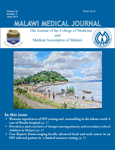
|
Malawi Medical Journal
College of Medicine, University of Malawi and Medical Association of Malawi
ISSN: 1995-7262
Vol. 19, No. 1, 2007, pp. 1-8
|
 Bioline Code: mm07001
Bioline Code: mm07001
Full paper language: English
Document type: Research Article
Document available free of charge
|
|
|
Malawi Medical Journal, Vol. 19, No. 1, 2007, pp. 1-8
| en |
Does the upgrading of the radio communications network in health facilities reduce the delay in the referral of obstetric emergencies in Southern Malawi?
Lungu, K. & Ratsma, YEC
Abstract
Setting: Mwanza, Phalombe and Zomba districts in the Southern Region of Malawi.
Background: Radios have been installed in many health centers in the Southern Region of Malawi but communication is often indirect. Messages get re-channeled from one health center to another before reaching district hospitals. In an attempt to strengthen the obstetric referral system, the Safe
Motherhood Project installed a repeater-based VHF radio communication system in three pilot districts. The overall goal of the new network was to enable the health centers to communicate directly to their district health offices (DHOs) for an ambulance when they have an emergency obstetric
complication for referral to the hospital.
Aim: This study aimed to determine whether or not improving the radio communications system reduces the delay in referral of obstetric emergencies from health center to hospital.
Materials and methods: Data collection was conducted between 2001 and 2003 using a range of data collection methods. Radio communications register books were placed at each participating health center to record information on all women with emergency obstetric complications referred
to the hospital for further management. An obstetric referral
form was completed on each woman referred to the hospital.
And using the same referral form, the referral hospital was
required to give feedback to the health centers on discharge
of the patient. Existing maternity registers or HMIS registers
were reviewed to obtain additional information not captured
in radio communication registers. Interviews with health
center staff were conducted to obtain their communication
experiences before and after the new network was installed.
Results: The average number of obstetric admissions per
month and the proportion of referrals in the participating
health centers significantly increased during the postintervention
period. Significantly more emergency obstetric
referrals were collected under 1 hour between decision
to refer by the midwife at the health center and arrival
of transport from the DHO or base station in the postintervention
period than pre-intervention period (p<0.02).
However, some patients still waited for more than 13 hours
for transportation in the post-intervention period. The
median time interval between decision to refer and arrival
of transport was 3 h. versus 2 h. 3 min. in the pre- and postintervention
periods respectively.
Conclusion: This study has demonstrated that the new
VHF radio network system has, without doubt, improved
the radio communication system in the three pilot districts.
However, although the time interval between the decision
to refer and arrival of transport significantly improved after
the intervention, the majority of transportation still took too
long, particularly for someone with postpartum hemorrhage.
It is very important to improve the management/control of
obstetric ambulances at district level so as to complement
efforts of an improved radio communication system in
reducing delays in the referral of obstetric emergencies.
Keywords
maternal mortality
|
| |
© Malawi Medical Journal
Alternative site location: http://revista.uft.edu.br/index.php/jbb/index
|
|
